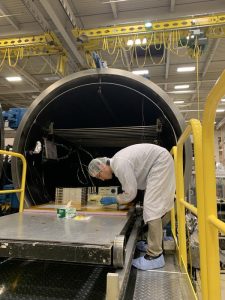Advancing the Study of Gamma-Ray Emissions
The U.S. Naval Research Laboratory (NRL) and NASA Goddard Space Flight Center (GSFC) will launch ComPair aboard a high-altitude balloon from Fort. Sumner, New Mexico Aug. 10.
The ComPair mission instrument measures and detects gamma-ray emissions from astrophysical objects. The NRL instrument is one of the four subsystem instruments led by NASA GSFC.
“They do so via three dominant processes – photoelectric effect, Compton scattering, and pair production. These interaction mechanisms depend on energy, where photoelectric occurs at the lowest energies and pair production at the highest,” said NRL Space Science Division Research Physicist Richard S. Woolf, Ph.D. “The design of the ComPair instrument employs technology to measure gamma rays from both the Compton and the pair production regimes, hence Compton-Pair or ComPair.”
“Gamma rays allow us to study the highest-energy processes in the universe: ranging from nucleosynthesis in supernovae; jets from supermassive black holes; and gamma-ray bursts from the merger of astrophysical objects with extreme densities, like neutron stars and black holes,” Woolf said. “The atmosphere primarily blocks astrophysical sources of gamma rays from reaching the ground at sea level.
The goal of developing this instrument is to increase the technical readiness level (TRL) of this gamma-ray technology. One of the last steps in advancing the TRL for gamma-ray tools is to fly on a high-altitude balloon.

“The hope is that what we learn during this phase will be applied to a larger, more sensitive mission that goes into orbit for a future NASA-led mission known as the All-sky Medium Energy Gamma-ray Observatory eXplorer (AMEGO-X). AMEGO-X is a medium-class mission that will be proposed to the NASA Explorers program announcement of opportunity, expected in 2026,” Woolf said.
After the launch of the Fermi Gamma-ray Space Telescope in June 2008, the gamma-ray community started to consider where they should focus their attention next. The idea was to use a similar design to Fermi but with sensitivity in the much lower-energy range of the gamma-ray spectrum.
“The ComPair instrument design is based on a previous NRL-led instrument, the Fermi Large Area Telescope (LAT) calorimeter, Woolf said. “ComPair expands on the technology of the Fermi-LAT calorimeter by using a novel scintillation light readout device known as a silicon photomultiplier (SiPM) coupled to the crystals that comprise the calorimeter. These SiPMs are more sensitive for reading out scintillation light, enabling gamma-ray detection in the Compton region.”
The NRL Space Science Division advances technical capabilities in the orbital tracking, radio communications, and navigation realms affecting the operation of ships and aircraft, application of the near-space and space environment of the Earth, and the fundamental understanding of natural radiation and geophysical phenomena.

